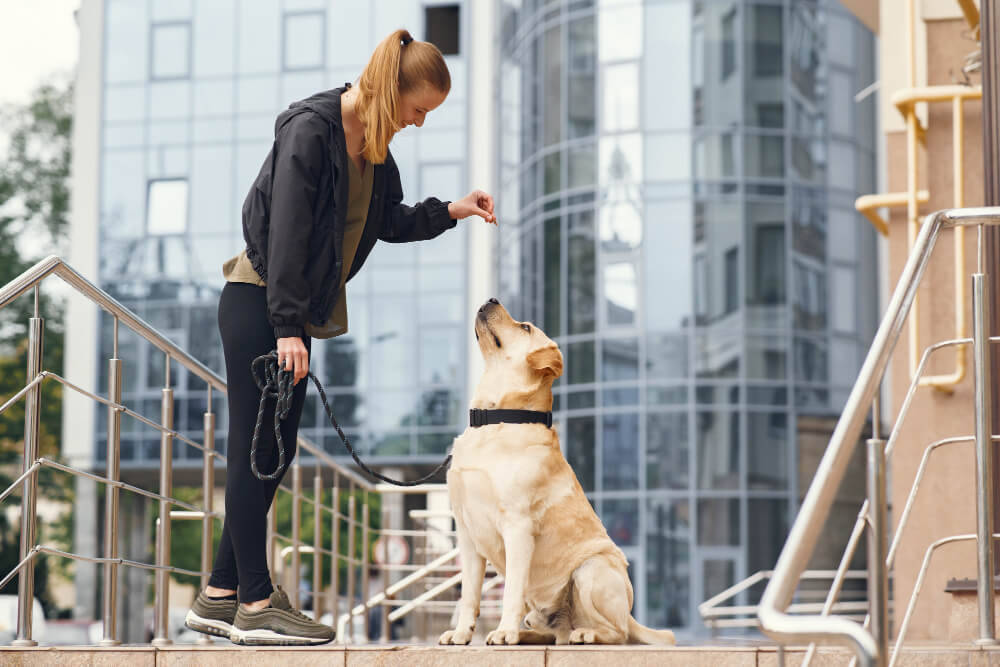(3)
Spend more to get free priority shipping
Great. You will get complimentary priority shipping for free.
Previous registration has been removed from the cart as only one animal registration is allowed at a one time.
Please note that there is no unified Assistant Animal database registration in the USA.
You cannot verify information from other registrars on the ESACERT.com website
Have you ever wondered how to catch a fake service dog? Spotting one is not always easy. Some dogs that people claim are for help don't act the way real service animals do. These pets can cause problems in public places and make it hard for true aid dogs to do their jobs. Service animals have special training to assist people with disabilities. ...


Have you ever wondered how to catch a fake service dog? Spotting one is not always easy. Some dogs that people claim are for help don’t act the way real service animals do. These pets can cause problems in public places and make it hard for true aid dogs to do their jobs.
Service animals have special training to assist people with disabilities. They learn tasks like leading someone who can’t see or alerting someone before a seizure hits. Our article will show you the signs of pets pretending to be service dogs and how this affects those who truly need these animals’ help.
Keep reading to find out more.
Identifying a fake service hound involves noticing its behavior closely. Real assistance canines show sharp focus and understand commands well, unlike imposters that might get easily distracted or disobey.
A real service dog shows great focus on their handler, ignoring distractions. They don’t get sidetracked by strangers or food because of their task training. This training helps them with tasks for those under the Americans with Disabilities Act.
If a dog seems too interested in other people or snacks around them, it’s a sign they may not be a genuine service animal.
Service dogs undergo rigorous training to perform specific tasks for those with disabilities, including mental health support and seizure alerts. When a dog lacks obedience and cannot stay attentive even in busy spaces, it raises questions about its certification as a service animal.
True service dogs have the discipline to maintain composure and focus, essential for assisting their handlers in public places.
Moving from the issue of focus, service dogs should also show good leash manners and obedience. Dogs that pull on their leashes or get carried in bags and strollers often lack proper training.
These behaviors are not typical for a well-trained service dog. Service animals receive special training to walk calmly by their handler’s side. They do not tug or try to run off.
Ignoring commands is another red flag. Trained service dogs know how to respond quickly to their handlers’ instructions. If a dog does not listen or acts poorly around other people, it might not be a real service dog.
True service animals know how to behave around others without growling or acting out.
A true service dog’s behavior reflects its rigorous training.
After discussing poor leash manners, we now turn to inappropriate behavior in public spaces. A real service dog behaves well around other people and animals. They don’t bark, whine, or destroy property.
If a dog shows aggression or has accidents in a store, it might not be a trained service dog. Real service dogs go through lots of training to act right in places like restaurants and shops.
Dogs that sniff everything, play too much, or bark at others don’t follow the Americans with Disabilities Act (ADA) standards for service animals. These actions can bother people and other animals nearby.
Owners who claim their pets as emotional support dogs without proper training put real service animals’ reputation at risk. The ADA gives public access rights only to dogs that help with disabilities in specific ways that emotional support animals do not.
Judging a service dog by its breed is a common error. People often think only certain breeds can be service dogs. Labradors and poodles are popular choices, but bulldogs and huskies can also serve as assistance dogs.
The American Kennel Club recognizes many breeds for their work in therapy and assistance roles. A dog’s breed does not determine its ability to support a person with disabilities.
Another mistake is expecting all service dogs to wear vests or display identification. The law does not require these animals to wear special gear or carry documents proving their status.
This leads to confusion about what defines a real service dog. Some people wrongly assume that an animal without a vest or ID is not legitimate, overlooking the fact that behavior, not appearance, indicates training and purpose.
States have set laws to stop people from lying about their pets being service animals. In California, if someone says their pet is a service dog when it’s not, they could face misdemeanor charges under Penal Code 365.7.
This means they broke the law in a serious way but not as bad as a felony.
In Florida, the punishment gets tougher with misrepresentation seen as a second-degree misdemeanor under Statute 413.08(9). Those caught might need to do up to 30 hours of community work for organizations that help people with disabilities or others approved by the court.
Texas and Washington also don’t take this issue lightly. Texas labels such acts as misdemeanors within its Human Resources Code Title 8, Chapter 121.006. Meanwhile, Washington sees it as a civil infraction according to RCW 49.60.214, which usually results in fines rather than jail time.
These penalties show how seriously the law takes the misuse of service dog titles and emphasize support for those who truly rely on these dogs for assistance due to visual impairments or other disabilities.
Identifying a counterfeit service animal necessitates a keen observation for indicators such as lack of concentration and unruly behavior. Genuine service animals comply fully and display appropriate demeanor.
Lawfully, owners can pose two inquiries for verification. Regulations don’t impose a requirement for these creatures to wear a vest or carry documents. A multitude of breeds make excellent service animals due to their intelligence.
Recognizing charlatans aids in safeguarding genuine disability assistance. It maintains the reverence deserved by these heroic creatures. Moreover, it reinforces legal protections for those in need.
Education plays a pivotal role in this venture.
There are resources available to gain further understanding on this crucial subject. Literature and online platforms provide comprehensive information on laws and animal behavior.
Every individual contributes to this cause, enhancing safety for all in various environments.
You can often identify a fake service dog by observing its behavior. Genuine service dogs undergo rigorous training and exhibit high levels of obedience, unlike other companion animals.
Service dogs are trained to perform tasks for individuals with disabilities under the American with Disabilities Act. Emotional support animals provide comfort but don’t require specific training like psychiatric service dogs do. Therapy dogs participate in animal-assisted therapy sessions in places like nursing homes.
Yes, any breed from German Shepherds to Airedale Terriers or even Pitbulls could be trained as a service dog. The American Kennel Club (AKC) doesn’t specify certain breeds for this role; it depends on individual temperament and ability.
There isn’t an official nationwide certification process or pedigree registry for service dogs according to the Air Carrier Access Act, which leads to misinformation about what constitutes legitimate documentation.
No, simply adding a vest does not make your pet into a legitimate Service Dog without proper training from certified trainers who specialize in areas such as traumatic experiences or mental disability assistance.
While well-trained Service Dogs generally show good behavior when leashed- they do not growl or act out fearfully – remember that they’re still living beings capable of having off days just like us.
Your current registration:
After change, your registration will be:
Your current registration:
will be replaced with:
You have entered the maximum number of characters
You have entered the maximum number of characters
You have entered the maximum number of characters
You have entered the maximum number of characters
You have entered the maximum number of characters
EC-0000001
Oct 29, 2025
-
-
-
-
-
-
You have entered the maximum number of characters
You have entered the maximum number of characters
You have entered the maximum number of characters
You have entered the maximum number of characters
You have entered the maximum number of characters
You have entered the maximum number of characters
You have entered the maximum number of characters
Enter at least 3 characters to search. You have entered: